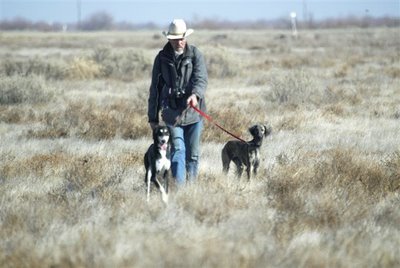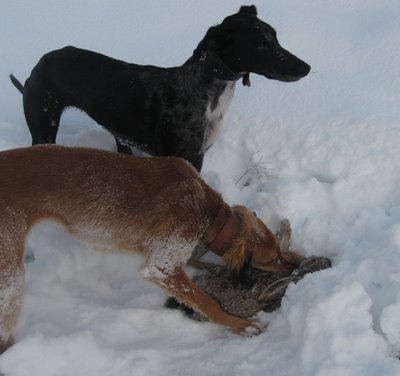Today, several friends sent me
this link to a New York Times piece on Asian "fighting" dogs.
I put "fighting" in quotes because the practice of testing wolf-guarding flock dogs, non-lethally, is an ancient one in Asia, pre-dating the mostly Islamic societies that now practice it, and is more akin to wrestling than fighting. The dogs signal when they have "had enough", a signal honored both by their canine opponents and by their owners, who have no desire to have their herd guardians crippled. But owners will generally not breed to a dog that will not stand up to an opponent. (I should mention that wolves are as common in most Central Asian back country as coyotes here, but more dangerous).
You might consider the practice a form of field trials for wolf- protection dogs.
Even scientists in the Stans and the Caucasus test their herd (and Border Patrol) breeders thus. I am in possession of a paper by two Azeri scientists (as yet unpublished so I can't post it yet) defending these matches while still deploring western dog fights.
Mary Scriver wrote: "Fascinating, Steve. Sounds like they are more like St. Bernards or Kuvasz or Great Pyrenees among the dogs we know. But the dogs look as though they'd just as soon skip the brandy kegs and knock back some vodka."
I replied: "You are exactly right. I suspect these are the ancestors of all that stuff. Similar ones also in Turkey-- here is one in the distance with a spike collar and a collar in a shop."


Matt also saw the St. Bernard resemblance:
"These dogs in the story look like tough customers. I was looking at their faces and kept thinking they looked familiar. Then it hit me: St. Bernards! What a dog the St Bernard must once have been...."
Me: "All the same descent I'm sure-- what the Romans called "Mollossian dogs" when they first came to Europe.
"I'd rather see them wrestle than be turned into drooling decerebrate mutants like modern show St. Bernards any time."
More pics; Libby with a tobet, the Kazakh version; and a good pic of the same dog. Fierce only when they have to be.


Matt here with a notice about the elephant in the room...
Steve and I were just musing on the significance (if any) of living in the last two states in which cockfighting is legal. I don't think it will be the case for long. I am not an advocate of pitting animals, but I think I understand it: the basic principle, and even the basic appeal. The few cockfighters I know are not simpletons, thugs, compulsive gamblers or drug dealers. They love their animals (no hyperbole) and know them very well. Moreover, these men are part of an actual native culture which---anymore---I am finding to be of value almost regardless of context.
I asked Steve, "Can we blog on this?"
He replied, "Yes. I've been thinking about how."
It's tricky, a little. I don't think you can dance around the AR and hunting and dog breeding and coursing and falconry realms and not in good faith address pit fighting.
My own position would NOT be in knee-jerk opposition, just to offer up a sacrificial lamb. For one, I don't really care much about pit fighting either way. It's just not my thing (which, incedentally, is how I replied to our city's animal control officer when, in a very cordial discussion some months ago, he asked me directly how I felt about it. My main concern---and part of the reason for that meeting---is that falconry not be confused with cockfighting. Let the two activities defend themselves from separate charges, at least.)
But more importantly, the "sacrificial lamb" theory doesn't work. The falconers who, in California some months ago, wanted to let the coursing enthusiasts twist in the wind should take note: The animal rights crowd wants it all. They are insatiable. They are not out to split hairs on these issues.
Consider the idea that these Russian dogs are being tested (and not "pitted" for its own sake). These dogs have a tough job (defending sheep from wolves!) and need to be demonstrably tough in order to make the grade for breeding. But instead of accepting that important distinction, the AR position would predictably be: "So what? A 'legitimate explanation' for an illigitimate job (sheep protection) is no argument at all."
Put simply, the animal rightists would rather have NO sheep to protect! And thus, no protection dogs needed.
Which begs the question: "OK, but what should these rural Russians eat, if not the meat of the sheep in need of protection? What should they wear, if not the wool of the sheep in need of protection?"
And to those questions, regardless what answers they give in debate, their real answer is, "We don't care."
Steve agrees, with the caveat: "But that's the argument they can't make to the public!"






























